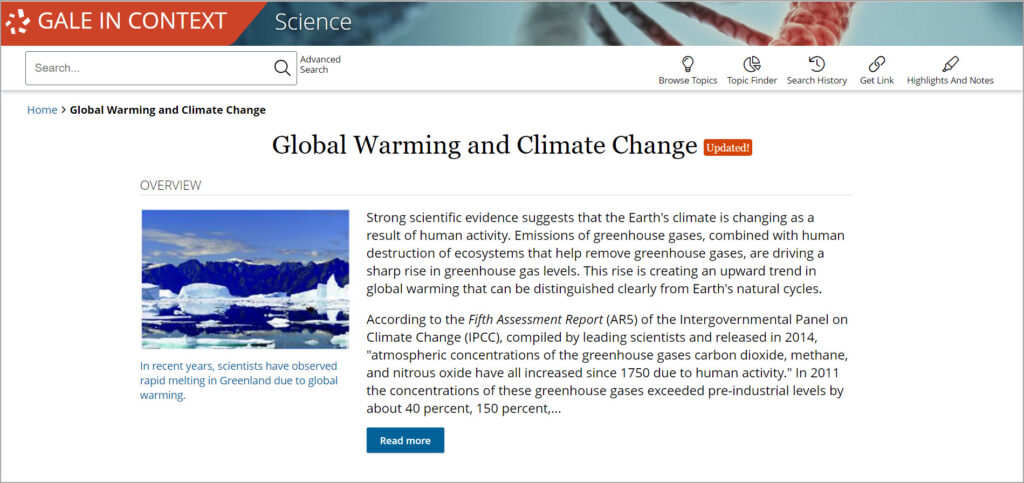| By Gale Staff |
STEM (Science, Technology, Engineering, and Mathematics) Day is November 8, and high school teachers can help inspire their students to get excited about a potential career in one of these fields. Highlighting STEM-related subjects celebrates an interdisciplinary approach to teaching that encourages young learners to ask questions, solve problems, think outside the box, and innovate. With U.S. students falling behind in math and science,1 showcasing STEM within the classroom is more important than ever.
Mastery of STEM principles is vital for long-term career success. Bureau of Labor Statistics data projects STEM-related occupations to grow by more than 10 percent over the next few years, and individuals in these professions make significantly more than the average U.S. wage.2 With Gale In Context: Science, high school teachers can easily integrate STEM lesson plans into their curriculum. Discover a student-dedicated portal with hundreds of topic pages and relevant news articles, scholarly journals, podcasts, videos, and biographies—all designed to spark curiosity and align with your district’s curricular standards. This November, show your high schoolers how cool the STEM field can be!
Tackle Climate Change
Climate change is one of the biggest concerns for Generation Z. For STEM Day (and throughout the school year), why not research some real solutions that scientists are working on to help fight climate change. Start with the Global Warming and Climate Change portal in Gale In Context: Science. Encourage students to research the most up-to-date summaries of the greenhouse effect and develop a solid understanding of the science behind global warming and its potential consequences.

Then, dive into some of the science- and engineering-based solutions currently underway by modern scientists. From solar panels to wind energy to composting to hydroelectric power, you’ll have no shortage of topics to explore with your high schoolers. Take advantage of helpful videos and experiments to help them understand the basic science and mathematics behind certain climate change technologies.
Activity Idea: Take a field trip to a nearby recycling center, solar farm, or a similar environmentally focused enterprise. Help students see real, practical innovations at work to help combat climate change in their own community.
Have Fun with Coding
Anyone can learn the basics of computer programming. With the prevalence of computer-based and artificial intelligence technologies in today’s workforce, coding skills can be helpful for any career path. Understanding the building blocks of programming languages also helps students develop their aptitude for logic and critical thinking. Like a foreign language, the earlier students begin engaging with these principles, the better their ability to absorb and understand their foundations.
You don’t have to be a coding whiz yourself. Educators can direct students to the history and fundamentals of computer programming, housed in Gale In Context: Science. High schoolers can develop a sense of the different language structures and even begin dabbling with the coding foundations for robotics. Find simplified resources to help students approach these complicated subjects—no matter their previous expertise or learning style.
Activity Idea: Illustrate the building blocks of computational thinking with this fun Walk Like a Robot from the National Science Teaching Association. One student plays the role of the “robot,” while their peers develop a series of commands for the robot to perform. As a class, reflect on any challenges that exercise presents and develop solutions.
Introduce Women in STEM
According to the American Association of University Women (AAUW), women comprise just 28 percent of the STEM industry.3 Despite major gains in other occupational areas, the STEM industry remains male dominated. Women have an important perspective in science and math, but they need role models to confidently enter the field. For STEM Day 2023, use Gale In Context: Science to highlight females and other minorities in the industry and their accomplishments despite adversity and limited representation.
Introduce figures like Margaret B. Davis, who, after earning her Ph.D. in biology from Harvard University in 1957, helped change how scientists understood animal and plant adaptation to climate change. Or discuss Sulochana Gadgil, an Indian meteorologist whose monsoon research-informed improvements in farming strategies and modern approaches to climate change–related major weather events. Using the biographies in Gale In Context: Science, teachers can show how future STEM leaders can represent any gender, race, or background.

Activity Idea: Have students choose an individual in the STEM field from an underrepresented population. Encourage them to research that person’s life and accomplishments, and report back to the class via a poster assignment or one-pager. Display their work around the classroom as an ongoing visual celebrating diversity in STEM.
Create Exciting STEM Lesson Plans
While Gale In Context: Science is designed with students in mind, the Gale team crafted a new tool specifically for teachers. After all, educators wear many different hats and work long hours. They deserve their own database. Gale In Context: For Educators can help you kick off your lesson plans for STEM Day and all year long. This special resource houses themed, ready-made activities; tools to assist those with diverse learning needs; and valuable shortcuts to simplify your daily responsibilities.
Use the Gale In Context: For Educators specially curated lesson plans, organize your assignments, introduce external resources, and guide student learning with embedded teacher notes and instructions. STEM topics can be challenging for some students—especially those who struggle with math. Leverage the specialized functionality in Gale In Context: For Educators to customize your lessons and better serve all students.
Make STEM Day 2023 an exciting holiday for your high schoolers. Consider visiting a science museum or the robotics lab at a nearby university. Above all, encourage students to see themselves in these valuable roles. The world needs the next generation to step up, innovate, and find solutions for today’s problems.
With the fall semester in full swing, let Gale’s databases help you integrate and highlight STEM-related topics. Even if students don’t ultimately pursue a career in the STEM field, they’ll develop invaluable skills and perspectives toward the world around them. If your school isn’t a Gale In Context: Science subscriber, contact your local representative to learn more.
1. Desilver, Drew, “U.S. Students’ Academic Achievement Still Lags That of Their Peers in Many Other Countries,” Pew Research Center, February 15, 2017.
2. U.S. Bureau of Labor Statistics, “Employment Projections,” last modified September 8, 2022.
3. AAUW, “The STEM Gap: Women and Girls in Science, Technology, Engineering and Mathematics,” accessed August 2023.

